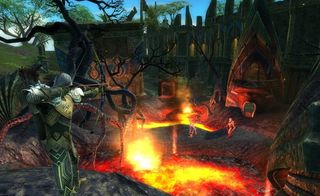
Ask GR Anything is a weekly Q%26A column that answers questions submitted by readers (as well as questions we're particularly curious about ourselves). Got a burning question about games or the industry? Ask us in the comments below and you may just get it answered!
Question 1: What goes on at an MMO developer when the game comes down for weekly maintenance?
This week’s first question comes from GR reader LongNuts (classy as usual, guys), who asked what Blizzard is actually doing every week when they take World of Warcraft down for several hours for “maintenance.”

Above: Not World of Warcraft
Well, unfortunately, Blizzard stood us up on a response to this. However, the very fine folks at Trion, who work on my personal favorite MMO, Rift: Planes of Telara (not just my favorite because they took the time to help with the article, though it certainly doesn’t hurt), helped us out with some insight on this issue. This answer was kindly supplied to us by Adam Gershowitz, a producer at Trion who works on Rift:
“Bringing servers down for scheduled maintenance is actually a very un-exciting thing, primarily because all of the exciting things happen in the weeks before as you stabilize for the patch. When the servers come down on patch day, it really is as simple as:
1. Bring the servers down
2. Update the servers with the new patch
3. Bring the servers back up for QA access only
4. Check the patch
5. Fix Issues
6. Unlock the servers
7. VICTORY
Many of you may wonder why it takes hours to do this if it’s “so simple.” All of that time goes into quality control. [We] spend a lot of time double- and triple-checking things before we open those servers back up, and sometimes that very simple step of “fix issues” can turn into a four-alarm fire for the whole team. That’s why we spend so much time testing things on our [Public Test] servers before the patch goes live.”

It may be a fairly ho-hum, boring process, as Gershowitz says, but clearly it can turn bad quickly if they’re not careful. So next time your MMO of choice is taking a while to come back up from patch maintenance, have a bit of patience. There’s a small chance the developers on the other side of the internet are frantically trying to re-stabilize their multi-million dollar product.
Question 2: How many “bits” are current-generation consoles?
Our bonus question this week comes from GamesRadar’s own Editor in Chief Gary Steinman. For being our bonus question winner, he will receive a complementary GamesRadar T-shirt. It should arrive in about 28 weeks in one-size-fits-all XXXL. Congratulations, Gary!
If you want the simple answer, modern-day consoles are 128-bit, same as most consoles of the last 10 years (even the Dreamcast was 128-bit). If that’s all you want to know, then thanks for stopping by, and we’ll see you next week. But you should probably know a little about what that actually means. I shouldn’t have to tell you that it does not mean that a 128-bit PS3 is only 16 times more powerful than an 8-bit NES. First of all, bits aren’t a measurement of raw computing power. They’re a measure of the complexity of the binary code that the system can process.

A “bit” is a short name for Binary Digit. The number of bits a computer system can process refers to the size of code (in binary digits) it can handle. Each space of a binary code is very simple and consists of either a 1 or a 0. But it can grow in complexity as you add more digits to the code. If it’s two digits, the complexity doubles to four possible outcomes (01, 10, 11, or 00). Every digit added to the code grows its complexity exponentially. 8-bit systems like the NES have 256 possible binary values.
So at this point, it should go without saying that a 128-bit system is staggering in its complexity. The total number of potential binary combinations in a 128-bit code is 2^128, or 340,282,366,920,938,463,463,374,607,431,768,211,456, or about 340 undecillion. Or in layman’s terms: a practically useless amount of data. In 2007, Sony engineers were quoted as saying that most operations work fine in 32- or 64-bit.
In the past, console manufacturers would trumpet the number of bits their consoles could handle because it was an easy way to claim superiority over a competitor. It was one number, pure and simple. These days, the number of bits is so large as to be almost completely meaningless, especially since all the consoles are on the same level. So instead, the number of CPU cores in the console tends to be the most talked-about tech-spec.
Submit your own questions in the comments (or Tweet them to @sciencegroen) and we may tackle them for a future Ask GR Anything.
